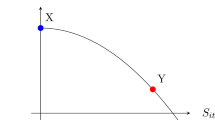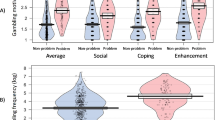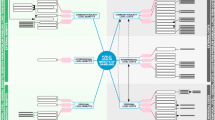Abstract
A theoretical model of gambling behavior is introduced which examines the linkage between regular gamblers, the gambling institution, and outside society. This model is based on participant observation in an urban casino and a review of the related literature. The intention is to explore the structural and cultural factors operating both in society at large and in a gambling institution and to connect them with the personal characteristics of avid regular gamblers to explain their gambling behavior and its consequences. The main conclusion is that the gambling institution with its social rewards and the perceived threatening nature of the wider social structure are the dominant forces in attracting gamblers and in shaping their subsequent gambling entanglement.
Similar content being viewed by others
References
Abt, V., Smith, J.F., & McGurrin, M.C. (1985). Ritual, risk, and reward: A role analysis of race track and casino encounters.Journal of Gambling Behavior, 1(1), 64–75.
Alberta Government (1990).Alberta Gaming Commission annual review. Edmonton, Alberta.
Breton, R. (1964). Institutional completeness of ethnic communities and personal relations to immigrants.American Journal of Sociology, 70, 193–205.
Campbell, C.S., & Ponting, J.R. (1984). The evolution of casino gambling in Alberta.Canadian Public Policy, 10(2), 142–155.
Cavan, S. (1966).Liquor license: An ethnography of bar behavior. Chicago: Aldine.
Coulombe, A., Ladouceur, R., Desharnais, R., and Jobin, J. (1992). Erroneous perceptions and arousal among regular and occasional video poker players.Journal of Gambling Studies, 8(3), 235–244.
Dickerson, M., & Adcock, S. (1987). Mood, arousal and cognitions in persistent gambling: Preliminary investigation of a theoretical model.Journal of Gambling Behavior, 3(1), 3–15.
Driedger, L., & Church, G. (1974). Residential segregation and institutional completeness: A comparison of ethnic minorities.Canadian Review of Sociology and Anthropology, 11, 30–52.
Goffman, E. (1961).Asylums: Essays on the social situation of mental patients and other inmates. New York: Anchor.
Goffman, E. (1963).Stigma: Notes on the management of spoiled identity. Englewood Cliffs, N.J.: Prentice-Hall.
Hayano, D.M. (1982).Poker faces: The life and work of professional card players. Berkeley: University of California Press.
Holtgraves, T.M. (1988). Gambling as self-presentation.Journal of Gambling Behavior, 4(2), 78–91.
Knowles, E. (1976). Searching for motivation in risk-taking and gambling. In W. Eadington (Ed.),Gambling and society: Interdisciplinary studies on the subject of gambling. Springfield: Charles C Thomas.
Kogan, N., & Wallach, M.A. (1964).Risk taking: A study in cognition and personality. New York: Holt.
Kusyszyn, I. (1978). Compulsive gambling: The problem of definition.International Journal of the Addictions, 13, 1095–1101.
Lesieur, H.R. (1979). The compulsive gambler's spiral of options and involvement.Psychiatry, 42, 79–87.
Lesieur, H.R. (1984).The chase: Career of the compulsive gambler. Cambridge, MA.: Schenkman.
Lesieur, H.R. (1992). Compulsive gambling.Society, 29, 43–50.
Livingston, J. (1974a).Compulsive gamblers. New York: Harper & Row.
Livingston, J. (1974b). Compulsive gambling: A culture of losers.Psychology Today, 7(March), 51–55.
Martinez, T.M. (1983).The gambling scene: Why people gamble. Springfield, IL.: Thomas.
Peele, S., and Brodsky, A. (1992).The truth about addiction and recovery. New York; Fireside.
Rosecrance, J. (1985).The degenerates of Lake Tahoe: A study of persistence in the social world of horse race gambling. New York: Peter Lang.
Rosecrance, J. (1988).Gambling without guilt: The legitimation of an American pastime. California: Brooks/Cole.
Rosecrance, J. (1989). Controlled gambling: A promising future. In H.J. Shaffer, S.A. Stein, B. Gambino, & T.N. Cummings (Eds.),Compulsive gambling: Theory, research, and practice (pp. 150–151). Lexington, MA.: Lexington Books.
Sanders, G. (1978). An integration of shifts toward risk and caution in gambling situations.Journal of Experimental Social Psychology, 14, 409–416.
Snyder, W. (1978). Decision-making with risk and uncertainty: The case of horse racing.American Journal of Psychology, 91, 201–209.
Stryker, S., & Serpe, R.T. (1982). Commitment, identity salience, and role behavior: Theory and research example. In William Ickes & Eric S. Knowles (Eds.),Personality, roles, and social behavior (pp. 199–218). New York: Springer-Verlag.
Wagenaar, W.A. (1988).Paradoxes of gambling behavior. UK: Erlbaum.
Walker, M. (1992). Irrational thinking among slot machine players.Journal of Gambling Studies, 8(3), 245–261.
Author information
Authors and Affiliations
Rights and permissions
About this article
Cite this article
Ocean, G., Smith, G.J. Social reward, conflict, and commitment: A theoretical model of gambling behavior. J Gambling Stud 9, 321–339 (1993). https://doi.org/10.1007/BF01014625
Issue Date:
DOI: https://doi.org/10.1007/BF01014625




